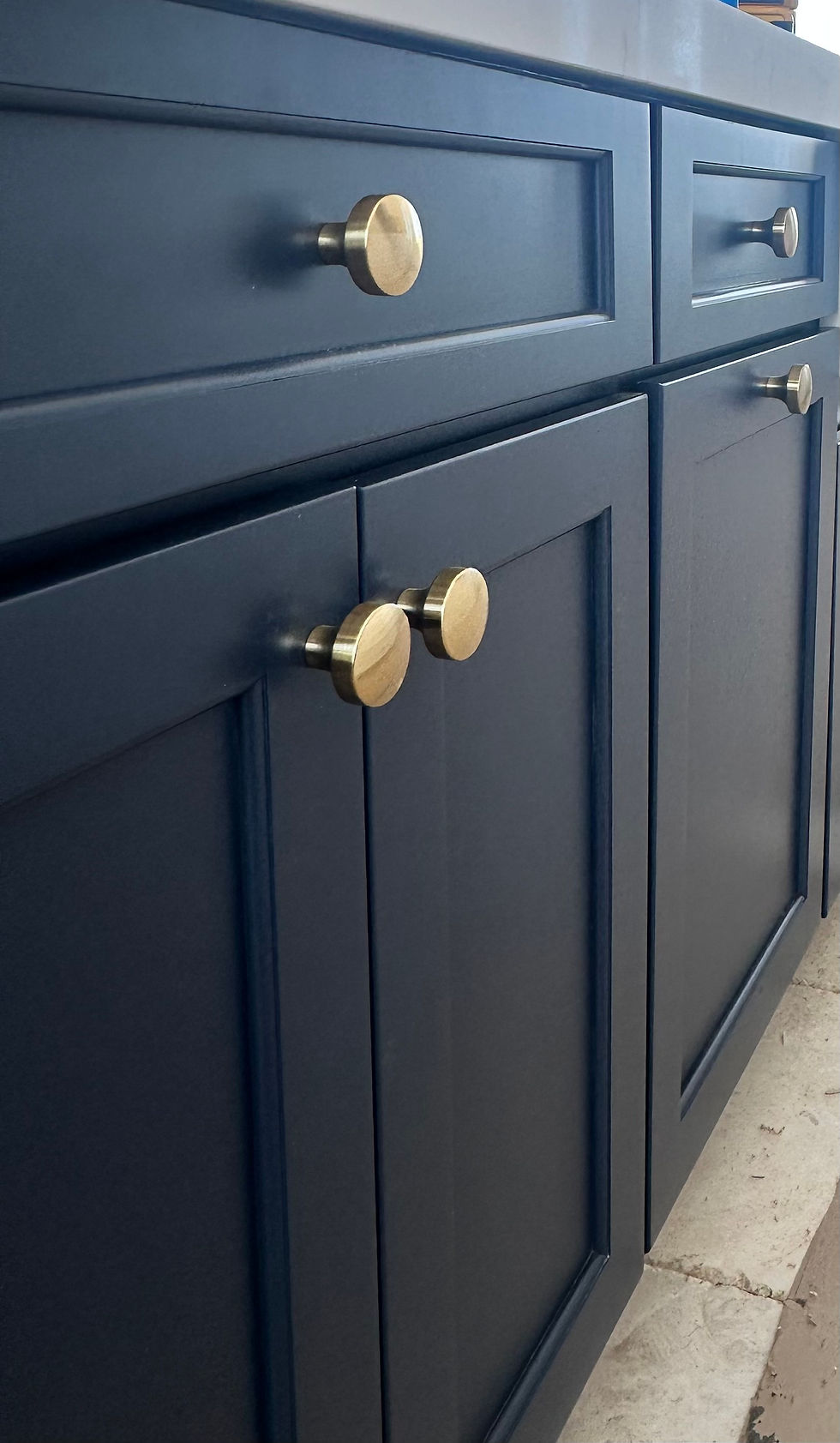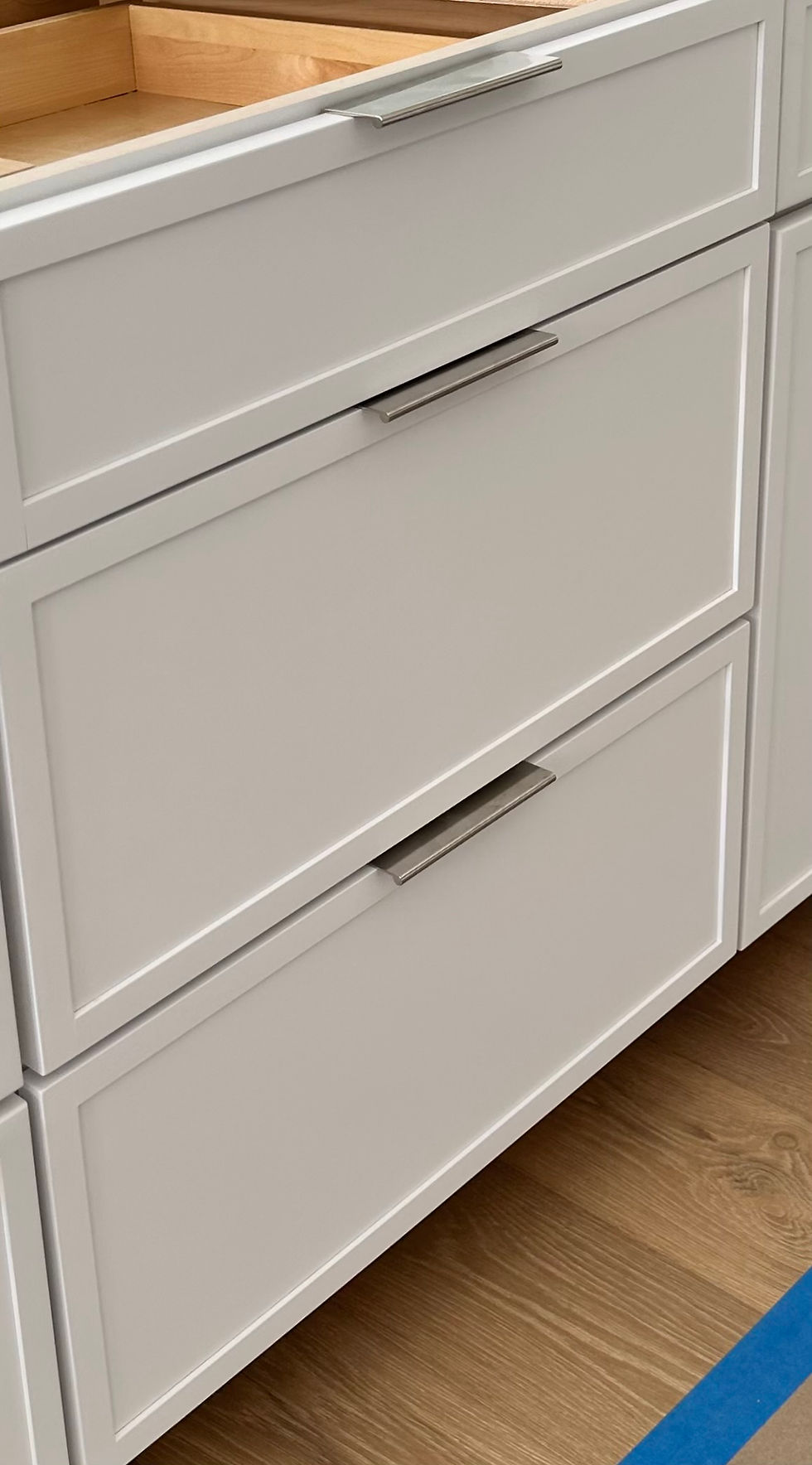The Ultimate Guide to Choosing Hardware for any Style Kitchen
- Janessa Erskine
- Mar 5
- 5 min read

Choosing the right cabinet hardware can be tricky, especially if you’re not familiar with the options out there. But don’t worry—we’ve created an easy-to-follow guide to help you pick the perfect knobs and pulls for your kitchen or bathroom.
This guide breaks down everything you need to know, from style to size to color—so you can make confident choices for your cabinets.
When investing in custom cabinetry, every detail matters—from the wood selection to the finish, and perhaps most importantly, the hardware that completes the design. More than just a functional necessity, the right hardware is the finishing touch that elevates cabinetry from beautiful to extraordinary.
Why Hardware Selection Matters in Custom Cabinetry
Custom cabinetry is a true investment in both the beauty and functionality of your home, crafted with precision and care to suit your unique space. Every detail matters, including the hardware. The right knobs and pulls, should not only complement the craftsmanship of your custom cabinets but also enhance their everyday use. By selecting hardware with intention from the start, you ensure a cohesive blend of style and function, elevating your cabinetry beyond aesthetics to a seamless, practical design element.
Types
The first step in selecting cabinet hardware for your kitchen is deciding between knobs, pulls, or a combination of both. Knobs offer a timeless, understated look and work well on cabinet doors, while pulls provide a comfortable grip, especially for bigger and heavier drawers. That said, there are no rules—vertical pulls can enhance bathroom cabinets, and small knobs can add a stylish touch to furniture like cabinets for an entertainment center or stacked cabinets. For a distinctive look, consider cup pulls for a farmhouse charm or sleek edge pulls for a modern, minimalist feel. Ultimately, your choice should balance aesthetics along with everyday functionality.
Knobs

Typically, smaller and best for doors, smaller drawers and provide a subtle look and are easy to install
Pulls
Larger and used for both drawers and doors, pulls offer a more contemporary look and make it easier to open bigger and heavy drawers.
Cup Pulls

A traditional and vintage option often found in farmhouse or traditional kitchens, providing an elegant touch.
Edge Pulls

Modern and minimalistic, edge pulls are hidden handles that create a sleek look in contemporary kitchens.
Style
When choosing hardware for your kitchen, personal preference plays a big role—but if you're unsure what works best for your style, there are some general guidelines to follow. The right knobs and pulls can enhance the overall look of your space, whether you’re designing a sleek, modern kitchen or a classic, traditional one.
Modern and Contemporary Kitchens

In contemporary or modern spaces, knobs and pulls can be used interchangeably to create a streamlined, cohesive look. Many homeowners opt for all pulls to achieve a sleek, minimalist aesthetic. If you prefer a balanced approach, consider using long, vertical pulls on tall cabinets and horizontal pulls on drawers, keeping the design clean and functional.
Traditional Kitchens

For a more classic kitchen style, the traditional rule applies: knobs for cabinet doors and pulls for drawers. This approach maintains the timeless charm of a traditional space, adding elegance without overwhelming the design. opt for ornate or antique-style hardware to complement raised-panel cabinetry and decorative molding.
By selecting hardware that aligns with your cabinetry style, you can enhance the beauty and functionality of your space while creating a cohesive design that feels intentional and polished
Coordinating with Fixtures
Create harmony in your space by coordinating hardware finishes with existing fixtures. While stainless steel hardware naturally pairs with similar fixtures, don't be afraid to experiment with mixed metals. Just remember to keep one finish dominant and use another as an accent. Black hardware creates stunning contrast against light cabinets or black hardware paired with black or darker color cabinets will create a sophisticated look, while brushed gold adds warmth to neutral spaces. For a cohesive and well-designed look, ensure that your island complements your lighting and sink fixtures. If you prefer to mix metals, choose a completely different color for the island to create contrast while maintaining visual harmony with your fixtures.

Functionality Matters
When selecting cabinet hardware, functionality is just as important as aesthetics. Comfort and grip should be a top priority, especially in high-traffic areas like kitchens, where ease of use matters. Durability is key—high-quality materials like solid brass or stainless steel ensure your hardware withstands daily wear and tear without losing its appeal. Additionally, since kitchen hardware is prone to grease and fingerprints, opting for finishes that are easy to clean and maintain will help keep your space looking polished with minimal effort.
Size and Placement Considerations
The right size hardware ensures both visual balance and practical functionality. Hardware that's too small can look out of place, while oversized hardware can overpower your cabinets.
When selecting pulls, size matters—not just for looks but also for functionality. A common rule of thumb is the ⅓ Rule, which suggests choosing a pull that is roughly one-third the width of the drawer. This creates a balanced, proportional look while ensuring easy usability.
How the ⅓ Rule Works
For example:
A 24-inch-wide drawer pairs well with a pull around 8 inches long.
A 42-inch upper cabinet door works best with a bigger pull between 10-12 inches long.
While the ⅓ Rule is a helpful guide, you can adjust based on your style preferences and functional needs.
Finding the Right Fit for Your Space:
For larger, heavy drawers, a longer pull makes opening easier, especially in high-use areas like pots and pans storage and trash cans.
For a modern look, stick with the ⅓ rule or longer pulls, as they enhance the sleek, streamlined aesthetic.
For a traditional or transitional style, shorter pulls can be a better fit, maintaining a classic and understated appearance.
For smaller cabinets, consider a slightly shorter pull than the ⅓ rule to keep the proportions visually balanced.
It is very important to measure your cabinets beforehand to ensure the hardware aligns and fits best with your cabinets.
Conclusion
The right cabinet hardware is a small but impactful detail that ties your cabinetry together.
Selecting hardware for custom cabinetry requires careful consideration of both aesthetic and functional elements. The right hardware not only complements your custom pieces but enhances their utility and longevity.
Remember, the investment in quality hardware is an investment in the longevity and functionality of your custom cabinetry. Choose pieces that honor the craftsmanship of your cabinets while meeting your practical needs for daily use. After all, it's the little things that truly make a house feel like a home.





Janessa
Great job and very informative, Thanks.